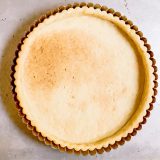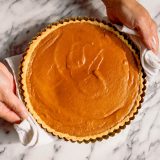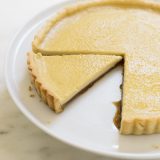I am no amateur when it comes to pie-making. I say that without hubris. It’s merely a matter of practice, having made more than a thousand pies since the ’60s. I can mend sticky or dry doughs. I can adjust to different fats. I can roll out a more-than-acceptable circle of dough without fuss.
Yet the prebaked crust remains an unsolved mystery. Either the dough is hard to roll out because it is so dry (a dry crust is less apt to shrink in the oven, as empty crusts are wont to do), or it rolls out fine, only to slump during prebaking.
Which had me asking why no one had developed a pie crust that is easy to mix, rolls out like a dream, handles and transfers well, and won’t slump in the pan when blind baked. So I asked Erika Bruce, a friend and expert baker, to revisit the issue one more time. I’m glad she did.
Essentially, we were searching for a way to stabilize a basic—but still excellent—pie dough, a technique that would allow the dough to stand up to any amount of handling and to handle any use, abuse or misuse, yet still bake up perfectly flaky and light.
How to make a tender pie dough that can stand up to rough handling? Doughs need moisture for a supple texture, but moisture activates gluten, the protein in wheat that makes doughs tough. We needed to add moisture without triggering more gluten.
The solution was cornstarch. By briefly heating a paste of cornstarch and water, we created an unexpected gel that was easily worked into the rest of the dough in the food processor.
Why did this work? The cornstarch gel traps the water it is made with, keeping it from reacting with proteins in the flour. This lets you add water to the dough without further gluten development.
We began by ignoring our instinct to fiddle with the usual suspects—type of fat, amount of fat, how to cut the fat into the flour, type of flour, type of liquid, as well as strange ingredient additions, such as vinegar, vodka and baking powder. No amount of tinkering with these variables was going to get us to the finish line. We needed a fresh start. We found it in Japan, but that turned out to be just the beginning of our journey.
Japanese milk bread is a pillowy soft white loaf with a tender, moist texture and fine crumb. This staple of Asian bakeries owes its lofty structure and airy chew to an unusual technique known as the tangzhong method. It’s actually pretty simple. A small portion of the flour is mixed with boiling water to make a paste. That paste gets mixed into the rest of the flour and water to make the dough. The paste—which changes the way proteins in the dough react—results in a more stable dough and a deliciously soft bread.
So for our pie dough, we tried a paste made from ¼ cup hot water and ¼ cup all-purpose flour. The results were good, certainly quite stable, but a tad too sturdy and not flaky enough. We knew we could do better. So we started thinking about what other paste-like additions could easily be worked into our simple dough.
We gave some thought to the science of pastry. Doughs need moisture for a supple texture, but moisture activates gluten, the protein in wheat flour that can toughen doughs. We wanted to add more moisture without triggering the development of excess gluten
Rolling pie dough like clockwork
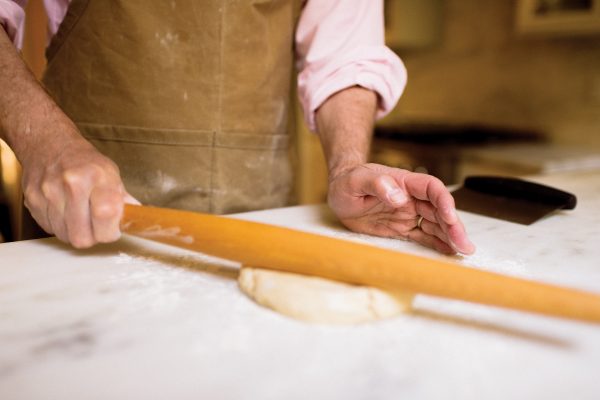
If the dough is cold from the refrigerator, soften it by whacking it with a rolling pin a few times or letting it sit at room temperature for 10 minutes.
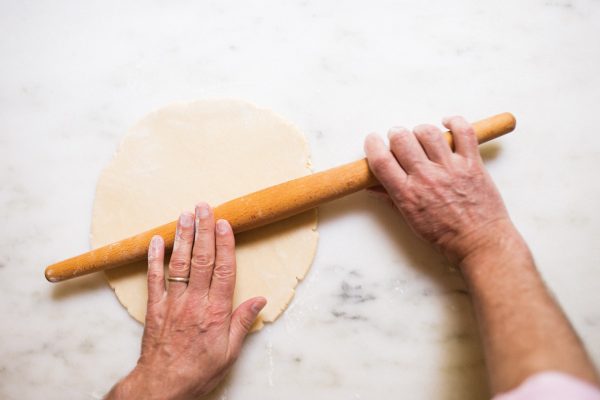
Roll downward in a 90-degree arc. Turn the dough clockwise 90 degrees and repeat. Continue this process until the dough forms an 8-inch circle.
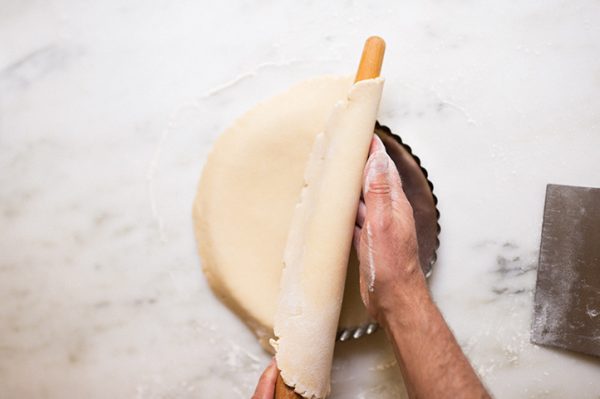
When the dough is 4 inches wider than the bottom of your tart pan, use a bench scraper to flip it up onto the rolling pin.
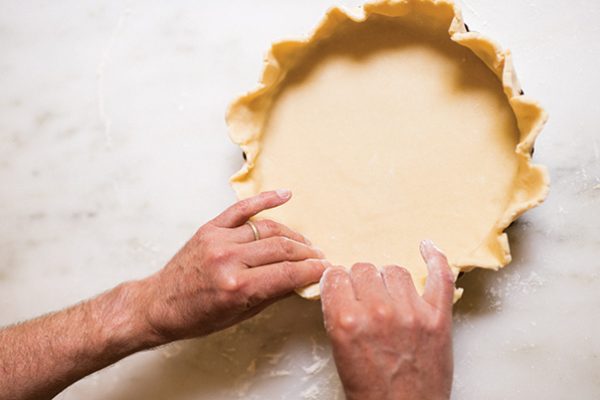
Lay the pie dough over the pan, ensuring it is evenly placed. Push the sides of the dough down into the edges of the pan.
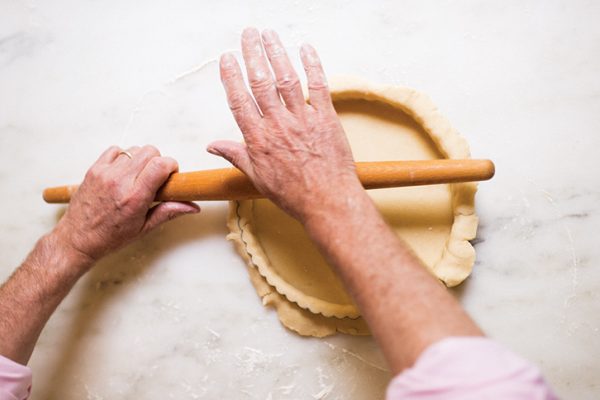
Lay the excess dough over the sides of the pan and trim using the rolling pin.
The answer came in a standard pantry item—cornstarch. Inspired by the tangzhong method, we made a paste of cornstarch and water, then heated it briefly in the microwave. This created an unusual gel. Once the gel was cool, we dumped all of our ingredients in the food processor and whizzed them together to form a dough. The resulting pie crust was vastly improved.
Why did this work? The cornstarch gel traps the water it is made with, preventing it from reacting with the proteins in the flour. This lets you add water to the dough without risking further gluten development. So you get a tenderer, relaxed dough. And do you know what relaxed doughs don’t do? They don’t shrink when prebaked! They also are easier to roll out.
Then we wondered if we could take this even further. Could we weaken the gluten even more without sacrificing the structure needed to hold everything together? Yes, we could, and all we needed was yet another kitchen staple—sour cream. Sour cream (all dairy products, in fact) contains a small peptide called glutathione. This peptide can be a baker’s secret weapon because it reduces the ability of the proteins in wheat to react and form gluten. And that means you get a softer, more forgiving dough. So even less slumping!
All the tinkering and science were worth it. The result was a bombproof pie dough that is simple to mix, rolls out with nary a hint of trouble, stands up to handling and moving, bakes up light and flaky, and doesn’t slump or shrink when prebaked. This is the pie crust we’ve all been searching for
